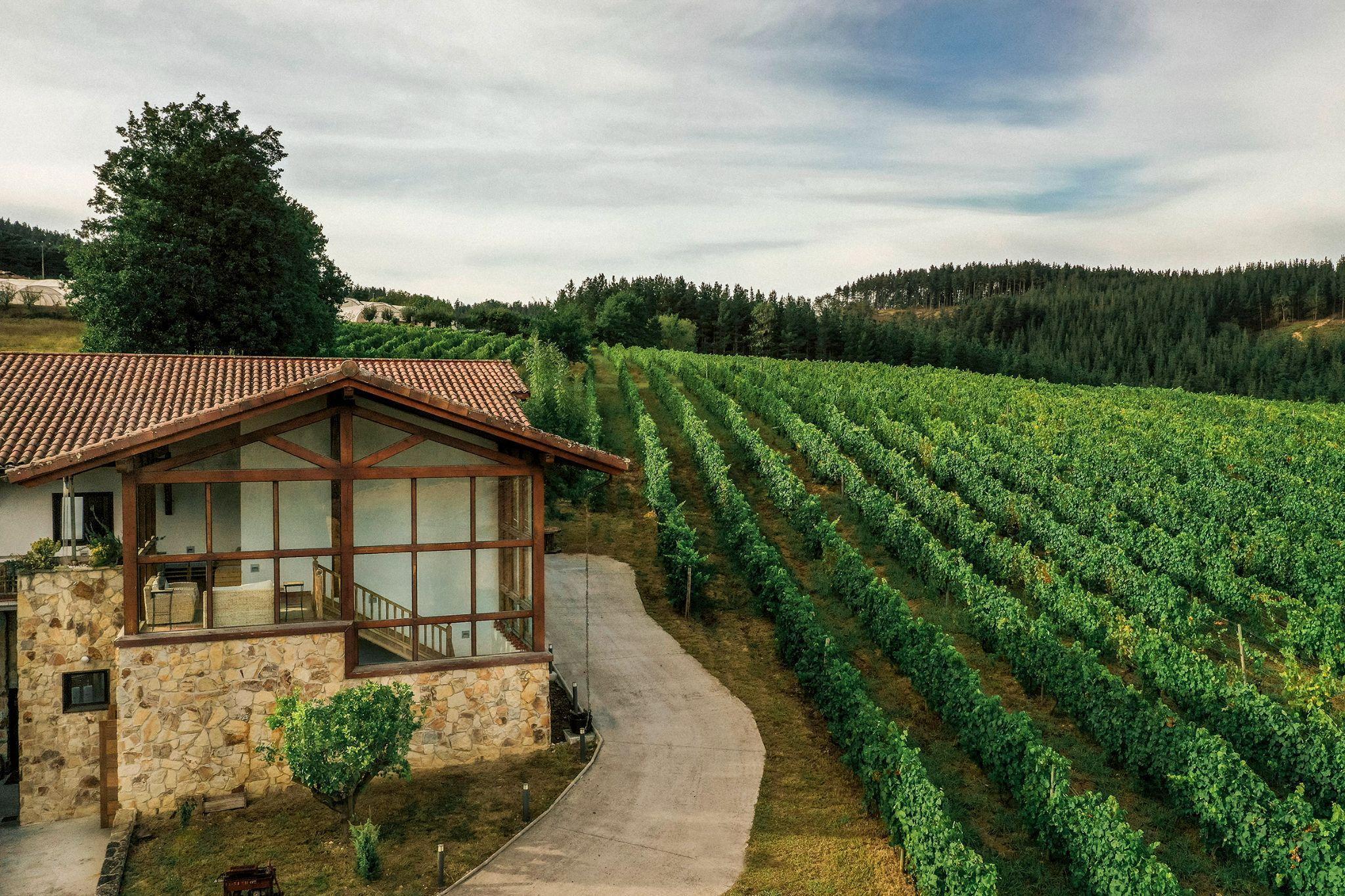KEY FACTS
CLIMATE: Atlanticwithcontinental influencewhichprovidesmorehoursofsunand lessrain
ELEVATION: 820feet(250m)
SOILS: Primarily clayloam,characterizedby alternatinglayersofhardrock(limestones, slates)andsofterrock (marlsorshales). Presenceofseashellsinsoilswithin2-3meters offossilizedseashells
CLASS: DO TxakolideÁlava
VINE: 17acres(7ha)plantedacrossseven micro-plotsareGPE-approved
KEY VARIETALS: HondarribiZuri, HondarrabiBeltza, IzkiriotaHaundia
ECO: Second European winery ever to achieve an Environmental Product Declaration certification
INNOVATE: Researchandproduction ofnewgastronomictxakolis,focusedon cellarsforagingwines
HISTORY
Astobizamaybearelativelynewwinery,but its wines are steeped in tradition. Wine production is likely to have started in the region as early as the ninth Century, and Txakoli production dates back to the 16th Century. Making use of exclusively native varietals,Astobizaproudlyembracesthisrich historywithavisionforthefuture.
THE FAMILY
Astobiza is a family affair. The Abando-Moyua family is the driving force behind the winery: Xabier Abando is passionate about caring for the estate, and his wife Begoña Moyua, known as “the Lady of Astobiza,” is Xabier’s staunchest supporter.
Álvaro Bujanda manages the winery, while veteran Spanish consulting enologists Anna Martín and Pepe Hidalgo help definethevisionforAstobiza’swines.Theiryearsofexperience helps guide the winery as they explore the potential of the grapesfromthepagoinmakingnewstylesofTxakoli.
Owner and founder:XabierAbando
SUSTAINABLE VALUES
Astobiza is committed to sustainability. They have been monitoring their carbon footprint since 2014, taking steps to minimize environmental impact. In 2015, they became the second-ever European winery to achieve Environmental Product Declaration (EDP) certification, which means they have been audited according to ISO 14025 standards. Bottling in particular has been revolutionized, using recyclable sugarcane stoppers, water label inks and capsules that are 100% aluminumandrecyclable.
TERROIR
In the valley of Ayala, the vineyards are defined by an Atlantic climate with continental influence, low diurnal temperature shifts and a 62ºF (16ºC) average temperature during growing season. Off the valley floor but still protected by the surrounding mountains, the vineyards avoid damaging frosts and fog.
Marlsinthesoilsareevidenceofanancient coral reef in the area, covered with more recent alluvial deposits. Deposits of slate and limestone are interspersed. Soil pH is neutral to slightly acidic. All are factors contributing to the freshness and notes of salinityinthewines.
FACT
Astobiza takes special care of Plot 1, which contains some of the oldest vines on the estate, nearly 40 years old.
The rich biodiversity of Astobiza’s lands encourages healthy vines and contributes to the signature profile of their Txakoli. Theypracticeminimalmechanizationandencouragespontaneouscovercropstosupportgoodsoilmanagement.
NATIVE VARIETALS: TRADITION AND INNOVATION
Hondarrabi Zuri is the leading variety of Txakoli, accounting for 97% of Astobiza’s plantings. The size of the bunches and berriesaresmallwithahighproportionofskinandseeds,andthevinesareprunedindoubleGuyotforlowyields.Thecool Atlanticairproduceswineswithtautminerality, well-structuredacidityandaromasofpear,citrusandfloralnotes.
Grapes are harvested and sorted by hand according to traditional methods. Dry neutral yeasts, cold maceration and controlled fermentations form the basis of their winemaking process. Among Astobiza´s innovations are vinifying Txakoli meanttoage.TheircuvéeMalkoaistheonlyTxakoliagedinconcreteeggswithitsleesforaround20months,pushingthe boundariesoftraditionalTxakoliproductiontoadddepthandcomplexity.
Astobiza also works to preserve lesser known local varietals like Izkiriota. Also known as Gros Manseng, Izkiriota has potential to produce wines with an intense flavor, high acidity and notes of apricot, quince, spices and florals. The timing of harvest plays a big role in the style of wine the grape produces. In Astobiza, Izkiriota is harvested late in order to produce sweet wine. Hondarrabi Beltza – the red to Zuri’s white – has a similar focus on acidity and freshness, and forms the backbone of Txakoli red and rosé.
How is the terroir reflected in the wines of Astobiza?
The wines express the unique nuances of the Hondarrabi Zuri grape as well as the terroir in whichtheygrow.ThemarkedAtlanticcharacterof the climate and proximity to the sea give the wines pronounced salinity, and the soil composition – made from a decomposed coral reef–impartsabriskminerality.
The estate sits above the mists of the valley, capturing all the solar energy thanks to its south-facing exposure, achieving a slow but sure maturation. All of these factors contribute to the character of the young wine, and their ability to makeaTxakolicapableofaging.
BODEGA ASTOBIZA PORTFOLIO:
Astobiza, Malkoa Private Reserve, Late Harvest
Singularities of the winery
Astobiza’s privileged location is protected by the surroundinghills,andbybeingelevatedabovethe conditions on the valley floor. The winery team is alsoknownfortheirdedicationtoinnovatingnew
Varieties
100% Hondarrabi Zuri
Vinification
About 12 months in stainless steel tanks
Good to Know
Use of inert gases and microbacterial filter help stabilize the wine and maintain freshness
Astobiza DO Txakoli de Álava





























